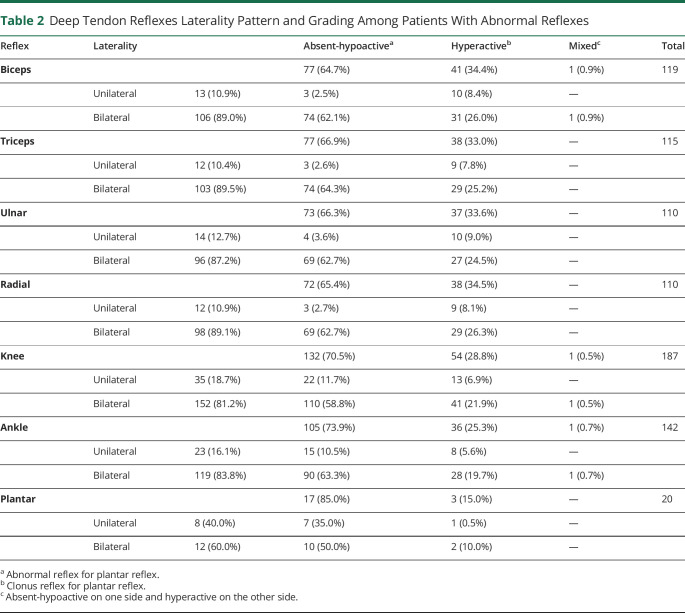Table 2.
Deep Tendon Reflexes Laterality Pattern and Grading Among Patients With Abnormal Reflexes
| Reflex | Laterality | Absent-hypoactivea | Hyperactiveb | Mixedc | Total | |
| Biceps | 77 (64.7%) | 41 (34.4%) | 1 (0.9%) | 119 | ||
| Unilateral | 13 (10.9%) | 3 (2.5%) | 10 (8.4%) | — | ||
| Bilateral | 106 (89.0%) | 74 (62.1%) | 31 (26.0%) | 1 (0.9%) | ||
| Triceps | 77 (66.9%) | 38 (33.0%) | — | 115 | ||
| Unilateral | 12 (10.4%) | 3 (2.6%) | 9 (7.8%) | — | ||
| Bilateral | 103 (89.5%) | 74 (64.3%) | 29 (25.2%) | — | ||
| Ulnar | 73 (66.3%) | 37 (33.6%) | — | 110 | ||
| Unilateral | 14 (12.7%) | 4 (3.6%) | 10 (9.0%) | — | ||
| Bilateral | 96 (87.2%) | 69 (62.7%) | 27 (24.5%) | — | ||
| Radial | 72 (65.4%) | 38 (34.5%) | — | 110 | ||
| Unilateral | 12 (10.9%) | 3 (2.7%) | 9 (8.1%) | — | ||
| Bilateral | 98 (89.1%) | 69 (62.7%) | 29 (26.3%) | — | ||
| Knee | 132 (70.5%) | 54 (28.8%) | 1 (0.5%) | 187 | ||
| Unilateral | 35 (18.7%) | 22 (11.7%) | 13 (6.9%) | — | ||
| Bilateral | 152 (81.2%) | 110 (58.8%) | 41 (21.9%) | 1 (0.5%) | ||
| Ankle | 105 (73.9%) | 36 (25.3%) | 1 (0.7%) | 142 | ||
| Unilateral | 23 (16.1%) | 15 (10.5%) | 8 (5.6%) | — | ||
| Bilateral | 119 (83.8%) | 90 (63.3%) | 28 (19.7%) | 1 (0.7%) | ||
| Plantar | 17 (85.0%) | 3 (15.0%) | — | 20 | ||
| Unilateral | 8 (40.0%) | 7 (35.0%) | 1 (0.5%) | — | ||
| Bilateral | 12 (60.0%) | 10 (50.0%) | 2 (10.0%) | — | ||
Abnormal reflex for plantar reflex.
Clonus reflex for plantar reflex.
Absent-hypoactive on one side and hyperactive on the other side.

